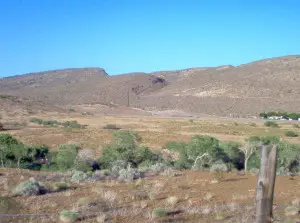FORT HARMONY
|
FORT HARMONY |
|
|
|
|
NAME: Fort Harmony COUNTY: Washington ROADS: 2WD GRID: 1 CLIMATE: Moderately Cold Winter. Warm Summer. Almost never snows. BEST TIME TO VISIT: Any time |
COMMENTS:
The original town has no residents, however there is a small town that is is now considered a part of. There are a few small towns nearby. REMAINS: Only the foundation stones of the fort. |
| Fort Harmony was founded by a man named John D. Lee as well as several other men in 1854. It was established along Kanarra Creek. The location of this townsite was settled just above a previously settled village named Harmony, which only contained a few small, primitive buildings at the time, which was settled in 1852. Fort Harmony, as the name suggests, was a fort. It was built on stone footings that were 3 feet thick and 300 feet long, forming a 300x300ft square wall. The wall itself was made out of thousands of adobe bricks. All of the buildings on the east side of the fort were one story, backing a 10 foot wall, but all of the buildings on the west side of the fort were two stories backing a 16 foot wall. The majority of the support holding up the fort was made of adobe, however some wood was used in some things, such as the roof. There were buildings outside of the fort, most of which were barns, which were also constructed of adobe and wood. The town was an agricultural town, so there were vast amounts of farmland stretching in all directions from the fort. Water supplies for the fort were the Ash River, Red Butte, and Kanarra Creek. Fort Harmony became the largest white settlement for miles, and so it was soon named the county seat of Washington County. It was also set up as headquarters of the Indian Mission, and providing many benefits for Indians. John D. Lee was appointed to be the Indian Agent, to work with the many peaceful Indians that gathered from several hundred miles around. In September 1857, John D. Lee left from this fort to participate in the Mountain Meadows Massacre, which occurred just miles from Fort Harmony. After the massacre, several children who were survivors of the attack were temporarily sheltered at Fort Harmony. In 1859, Fort Harmony was no longer the county seat, as it was switched by the territorial legislature to Washington, which then had the largest population in the county. Fort Harmony, however, despite this continued not only to survive, but thrive. In the early 1861, President Brigham Young, while touring the southern Utah colonies, stated his delight in this fort, saying that it was indeed the best fort in all the territory. At the time, it arguably was the best in all the territory, however it did have a major flaw that would be the fate of it. On December 25, 1861, the skies over Fort Harmony darkened and rain began to fall. This begins the storm of the century. Heavy wind and rain combined began to dissolve and pick away the adobe that the fort was made out of. The residents took note of this weather, and were fearful, knowing that it was going to be worse than anything that they could imagine. They were still lucky to be out of the flash flood zones that made up so much of the area, because they would at least be granted time to prepare and abandon. On January 1, 1862, the weather dropped well below 30 degrees Fahrenheit, allowing the rain to become snow. Snow began to pile up against the walls of the fort. Then over the next few days, the temperature climbed drastically and rain continued, melting all the snow, which took a massive toll on the fort. By this point, all underground rooms were completely flooded. The barns began collapsing spontaneously, and the walls began crumbling away. By mid-January, many of the buildings inside the fort were perforated and crumbling under the weather, causing many people to move in with other families whose homes were still secure for the time being. By January 18, 1862, all of the families, except for the Lee's had moved out of the fort and secured their wagons against any windbreak in sight, and tried to ride it out from there. On January 31, 1862, for the first time in 29 days, the sun shone through the clouds. This didn't last long, however. Soon a blizzard set in and ridiculously strong winds blasted through the forlorn ruins. Almost everything was destroyed after this. The homes were filled with 3 feet of water. On February 7, 1862, 44 days after the beginning of the storm, Mrs. Lee began to gather her children to leave the fort. In an instant, a powerful gust of wind erupted across the fort and blew down a section of the fort's wall, killing 2 of the children, and nearly killing 2 more. When the storm subsided, the mourning settlers did not return to the fort to rebuild. Instead, some of the settlers moved 5 miles west along the Ash River and founded the town New Harmony, and others went further up the valley and founded Kanarraville. Submitted by: Alex Barber |  Fort Harmony Courtesy Alex Barber |
|
|